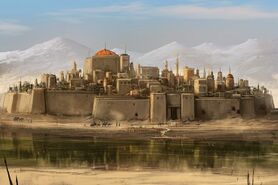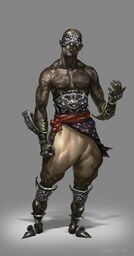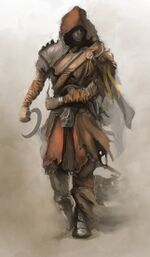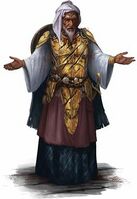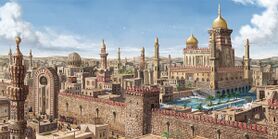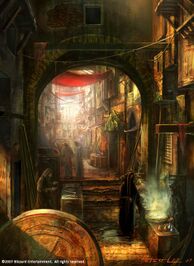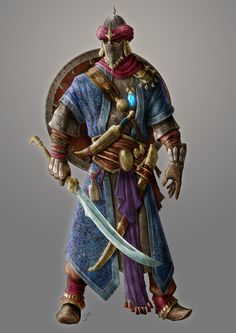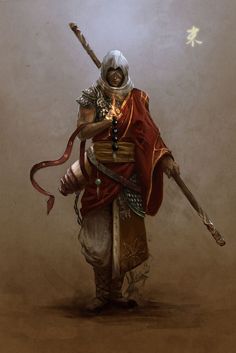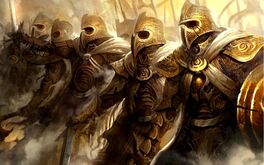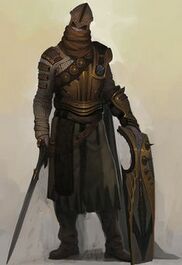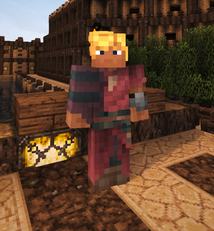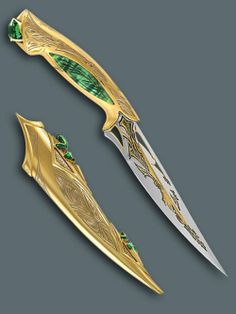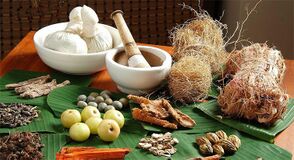Rune'Daath
Overview[edit | edit source]
Rested in the harsh desert continent of Rimal Al'ajdad, the people of Rune'Daathian Sultanate are an iron-willed people. With rich culture, a strong military and a quite specific way of life, Rune'Daathians are willing to go to any and all lengths to preserve this life they love so much, and seldom leave their continent, finding themselves most at home there, and other ways of life strange. Most lead a hardy life in Rimal Al'ajdad, only those who have the most riches live in a life of luxury.
Rimal Al'ajdad is a rather large continent, surrounded by a series of six smaller islands: Samakk, Tijara, Ahmid, Kharedan, Bilial, and Fahim. The mainland is typically what one speaks of when mentioning Rune'Daath, as the smaller islands mostly exist for the purpose of exporting and trade. No outsiders are allowed into the mainland.
Government[edit | edit source]
Nobility[edit | edit source]
Royal Family[edit | edit source]
Rune’Daath is run by a monarchy, based around the current royal family. The El-Hashem’s have ruled since the First Era. It is seen as taboo for any member to leave the Sultanate, unless by exile. Much of Rimal Al'ajdad has been complacent and accepting of the never changing family. They revere Jawahir El-Hashem as one of the greatest Fida'an. There have been several battles of those who would overthrow the family, almost succeeding in some of the attempted coups, though, the trained military has always emerged victorious.
The current Sultana, Dhakiyah El-Hashem, is quite progressive, going as far as to leave the continent to speak with foreign leaders; many speak her name with disdain because of it, though few see it as the natural way of progress and welcome it as long as it isn’t taken to an extreme.
Alrraei[edit | edit source]
Though uncommon, there are a few Rune’Daathians that exemplify the qualities revered by the desert civilization. These people who serve valiantly and achieve feats of great measure are considered an Alrraei, one who will pass and be revered as the Fida'an who tore Abia from her throne. This is an incredible honor and can even raise the family out of poverty, allowing them to live comfortably for the rest of the bloodline’s existence. The Alrraei that survive and live to tell the tale are allowed positions of importance among the government. Often working closely with the leaders of the military, and even the current Sultan/Sultana.
The Emirs[edit | edit source]
The Emirs are the families in charge of the various provinces of Rune’Daath. They are directly under the current Sultana, and answer only to her, the highest ranks of the army, and the currently living Alrraeis. They work very similarly to the Sultan's bloodline. It is very uncommon for the seat of the Emirate to change houses. It has happened a few times in history, in which a house decided to try and rebel or overthrow the Sultan at the time. The house is quickly removed and replaced with one of the Syd Alttajir.
Social Statuses[edit | edit source]
Rwh Alkhayin[edit | edit source]
The opposite of the Alrraei. These are families of Rune’Daathians who had multiple members of the family banished from the Sultanate. This has caused the entire family to be removed from society. The Rwh Alkhayin tend to travel in large groups of caravans, settling momentarily in areas to try and find others to trade with. Covered in head to toe with tattoos so as to have no way of hiding who they are if they attempt to enter society again.
All of the Sultanate’s citizens fear becoming one of the roaming caravans, as far as to quickly correct the children who might show signs of non-ideal behaviors. Though, there are some who despise the ways of the cities and how the city is run. These are people are called
Most of these roaming clans are peaceful, though there are few who will attack trade caravans or patrols that wander too close. There are many stories behind these nomadic people, covered in the dark ink, traveling through the dunes of Rimal Al'ajdad.
Tathir Alkathban[edit | edit source]
Members of this status are born exiles. Though, they’re exiles trained to hunt down those who would try to re-enter society. The members of this are imposing and a fear to all exiles who would dare think of trying to re-enter. Known for their intense torture methods, these are not people to be messed with. They are silent defenders who are appreciated by no one. To leave the dunes and abandon their duty would mean to put themselves and their families to the blade, and the same torture given to the exiles they capture.
Legends surround them, stories of dragging men behind their horses with ropes. Captured exiles being given minimal food or water, a crumb and a drop a day. Capturing members who tried to escape, and forcing them into servitude until they die.
Syd Alttajir[edit | edit source]
The ones in charge of large merchant companies and reach a faux-nobility status. These people usually hold a high position in small villages based around trade, or a position in a merchant’s guild in larger cities. Syd Alttajir are able to provide for their family and hold great feasts and parties. Some specialize in different resources to trade, ranging from crops to brothel workers.
Regions[edit | edit source]
The Emirates[edit | edit source]
The sultanate of Rune’Daath is divided into 5 emirates. The emirates are each led by their respectable Emir. Many cities in these lands are quite beautiful and pleasant to live in, as long as you’ve got money or are a member of the military. Laws in one emirate may differ from another. It is important to be aware of the laws of each, as it is seen as dishonorable to follow another emirate’s laws. This can only worsen the punishment ordered for you.
Easima [edit | edit source]
These are the revered lands, ruled directly by the Sultana of Rune’Daath. The Sultana’s land is the largest stretch of land in Rimal Al'ajdad. It stretches from the border to Ulyssia, down to the southern shores of the Sultanate.
Many refer to this region as the ‘pleasure’ region. It boasts plenty of breweries, brothels, and fighting areas. This is where a majority of Rune’Daath’s history lies, making it one of the most culturally rich areas of the Sultanate. Plenty of relics and texts from ancient times are yet to be uncovered.
Sultana: Dhakiyah El-Hashem
Capital: Madinat Alttabjil
Khalij[edit | edit source]
Khalij is the native food center of Rune’Daath. It specializes in fishing and using the little fertile land is used for growing hardy plants. Many cities and farming lands boast large and plentiful aqueducts, large basins built in the areas that get most of the coastal rain water.
Caravans are a common sight, as they’re constantly sending food out to the other regions. Livestock is commonly raised and slaughtered here; chicken, oxen and goats make up the entirety of meats, alongside fish. Maize, groundnut, millet and sorghum are
common crops. This is where much of the spices and peppers, that flavors much of the food, come from.
Emir and Emira: 'Ajib and Sajida Nejem
Capital: Khitaf Al'asmak
Jadar[edit | edit source]
This region is where much of the trade between Rune’daath and Zavwhan. Jadar is the home of the Rune’daathian Navy, several large ports are built off the shores of this region. Jadar is referred to as ‘the wall’. It stands between Rimal Al'ajdad and Zavwhan, most trade between the two is done through this region.
Foreign boats are kept a distance from a port, and met by a Rune’Daathian boat to trade the goods. Trade is important for them, but they will not allow foreigners onto the mainland.
Emir: Haytham Saab
Capital: Alhajiz Al'asli
Qarab[edit | edit source]
A region some call the sparkling dunes and shining seas, and is considered Rune’Daath’s wealthiest region. This is home to many quarries, mines, and trade ports. Most of the shining gems that Rune’Daath adores are found in the stone hidden beneath the sand. Qarab is home to many miners, jewel cutters, and traders.
Most, if not all of the jewelry found in Rune'Daath is produced here and many scholars seek out certain gems they read about in books here. Many trading ships are stopped just short of the shores, this is common practice amongst those who trade with Rimal Al'ajdad. Foreigners who attempt to dock in these ports are not met with hospitality. This was once the northern area of Almawani before feuds caused the emirate to be split into two.
Emira: Zakiya El-Zein
Capital: Satie Alkrystal
Jawhira[edit | edit source]
A region that most fear, as it is notorious for many roaming caravan villages made up of the Rwh Alkhayin. This is also home to the Tathir Alkathban, those that hunt down the exiles trying to re-enter society. The region is home to the training of the specialist branches in the Grand-Sultana’s Army. The sound of marching, fighting or sounds of pain are common to this area. This is where Rune’Daathian boys and girls become one of many, a soldier to serve and protect the dunes.
Emir and Emira: Kedar and Shudun Zafar
Capital: Mujallakha
Military[edit | edit source]
In Rune'Daath, the military is a way of life, harboring some of the greatest warriors in the realm. With very specific fighting styles and unique guerrilla tactics, Rune'Daathian incorporate the use of scimitar blades as well as earth and fire magic. A Rune'Daathian warrior is truly a foe to fear, known to be ruthless and unrelenting, not willing to give up even when in the face of a bitter end. Being able to fend off any foe who try and enter their land, the warriors of Rune'Daath are a renowned and prestigious military order, despite their rag-tag seeming tactics.
Commanded by the Grand Sultana of Rune'Daath, the soldiers of this land are a well trained fighting force. They fight out of love for their home, rather than for coin or out of fear, even, and wish to protect it at any and all costs. Joining the military is quite common practice for any citizen, most children being trained in the art of swordplay from a very young age, and even magic if they are able. The warriors of Rune'Daath often decorate their hair with with braids and baubles, typically the higher one is in a military rank being symbolized by the number of braids one has.
Magic is a highly revered, uncommon force in their military, using the element of fire, symbolic of the harsh desert conditions they live in. Surrounding the capital of Rune'Daath, Madinat Alttabjil, are large sandstone towers with gleaming gems fixed at the top. These towers were put in place by Sultan Abdul-Haqq El-Hashem, renowned as the only sultan to be a magic user, as a drastic defensive measure. Any magic user in the city is to report to these towers and channel their arcane ability to it, resulting in the formation of an arcane barrier that acts as a shield.
Branches:[edit | edit source]
El'Musheht; The Infantry[edit | edit source]
Abundant in numbers, this is where all Rune’Daathian soldiers begin their legacy. Typically at the age of sixteen, young men enlisting are placed within El’Musheht, where they serve as the basic footmen within the military. From here, they receive their basic training and begin service in one of hundreds of small four-member cadres. Within each cadre is a higher ranking member, who serves as a teacher and leader for the others. These groups are best known for their tactics in the field, launching chaotic but well organized attacks that strike before the enemy can react. Each member of El’Musheht is versed in combat with sword, shield, spear and knife, but almost as deadly while unarmed.
Forasahni; The Cavalry[edit | edit source]
A step up from the El’Musheht, the Forasahni are the revered house-mounted soldiers of Rune’Daath. They are an extremely agile, and equally deadly division capable of mounting attacks of traversing great distances in remarkably short amounts of time. Their warriors are skilled enough to fight on horseback, and their archers can even land a passing shot with deadly accuracy. Typically they are used to handle pressing issues that need immediate rectification and for handling crowds, able to move faster than someone on foot and strike down and subdue criminals, but they are also useful in serving as the forward parties and scouts within the Rune’Daathian military. The Forashani are also used to escort caravans, and sometimes accompany cadres of El’Musheht to provide guidance and assistance.
Rohkiib; The Senintels[edit | edit source]
They are the force which defends the great cities of Rune’Daath, securing the walls from outside invasion and threats to the homeland. The Rohkiib consist primarily of Rune’Daath’s archers and mages, able to take down any threat that approaches the walls and maintain power within the crystals that adorn and protect them. Typically the Rohkiib consist of the more experienced soldiers, promoted through the ranks of El’Musheht once they have demonstrated their talent. While rare, there are a few individuals among this group who are younger, although the natural talent required is not entirely common. Defending the walls is one of Rune’Daath’s highest honors.
[edit | edit source]
The smallest of the major branch, El’Ahstul is but a tiny part in protecting the mainland of Rimal Al'ajdad. Equipped with smaller, fast moving ships they patrol the coasts of Rimal Al'ajdad, ensuring trade continues as intended while also keeping watch on the outer islands where the mainland forces are less prevalent. In some instances, El’Ahstul will escort important trade fleets, as well as engage the crime syndicates plaguing their waters. While not as popular of a choice among recruits, those who seek to join El’Ahstul do so to branch out from the mainland, or to protect their homes in the surrounding islands.
Specialist Branches:[edit | edit source]
The Sultanguard; Protectors of the Sultan[edit | edit source]
The highly skilled, professional, and loyal personal guard for the Sultan and the royal family. Securing a spot among the elite group is no easy process-- Each individual is handpicked by the Sultan themselves, typically being accepted after inheriting the role from a parent. These few guards dedicate their entire lives to service of the royal family, giving life and limb to protect them and their security. The ruling Sultan is hardly ever seen without at least one member of the Sultanguard present, constantly on the look out for potential threats. Their services even go as far as tasting the Sultan's food and drink first.
Amehleha; The Juggernauts[edit | edit source]
The heavily armoured elite of Arshia’s Great Army, the Amehlha are the unstoppable soldiers equipped in the strongest armour Rune’Daath has to offer. Each one is hand picked and specially trained by the Sultanguard to handle any threat they are faced with. Due to the weight of their armour, and its limitation the Amehleha are few in numbers and rarely called upon, but when they are few can stand in their way or even hope to contest them.
Shibha; The Spectres[edit | edit source]
A rarely spoken of group, the Shibha are the highly effective, stealth operations regiment of the Great Army. Only the Sultana and Alrraei truly know the extent of their numbers, but it is said they are chosen among the ranks of El’Musheht early on and trained for years before they are put to use. Their missions consist of the most sensitive and risky operations carried out by anyone outside of the Sultanguard, and they are often overseen by a member of it.
Mohtahb; The Trackers[edit | edit source]
Not all threats within Rune’Daath are human in nature, as the lands are full of dangerous beasts that prey on the weak and careless. Within El’Musheht there is a regiment tasked with controlling the presence of beasts within Rimal Al'ajdad, ensuring that they do not endanger any fellow soldiers or citizens of Rune’Daath. Equipped to capture of dispatch almost any of Rimal Al'ajdad’s great beasts, they are excellent marksmen, trackers and hunters that know the lands like the back of their hand.
Religion[edit | edit source]
The Rune'Daathian’s beliefs are not much of a religion at all. There are no churches, no written texts. No formal gatherings of worship or even concrete beliefs. Interpretations may vary from family or region. Their belief are strictly told through oral traditions, believing that documenting or worshiping it in some formal way would be disrespectful to the legend of their ancestors, as they would not wish to be worshiped as gods.
Rune'Daathians believe that, at once, the harsh desert known as Rimal Al'ajdad was a lush, green land filled to the brim with nature and wildlife, not the barren wilderness that exists today. The Goddess , Abia, came down from the sky and created this land to harbor her creations-- The Rune'Daathians. After a time, she came to the conclusion that her creations were sinful and tended to partake in pleasures of mortals such as drink, coin, and sex. The perfect race of dark skinned, fair eyed people turned out to be just that-- People. Feeling disgusted with what she created, she wrote them off as a mistake, or a testing phase as to what she could create at a later date.
To punish her creations she deemed sinful, she damned the once beautiful continent to be the harsh desert it is today. Abia returned back to her Oasis in the sky. Feeling betrayed by their once beloved Goddess, The first Rune'Daathians that would become known as the "Ancestors" decided they were not terrible creatures of sin for partaking in worldly pleasures, and instead, that Abia was too harsh, and would never be satisfied with anything she created. They would rebel, and bow to no gods-- Ruled by nothing but themselves.
They discovered powerful magic, deemed Aladant Niema, by communing with their new desert surrounding and used them to construct pillars-- Pillars that stretched all the way to Abia's Oasis. Taking her by surprise with their newfound magic and sheer ability to reach her Oasis alone, they slayed their once god, freeing themselves from her damnation and becoming their own rulers. It is spoken by some that That some of the ancestors remained in the Goddess' Oasis, and that they shall join them upon death. Other's believe that the original ancestors now walk among Rune'Daathians, guiding their hand and luck in everyday actions. The concept of how their ancestors exist is the most common gray area of the religion today, regions and its people tending to have their own view on this.
They had also decided that they would, in fact, live in the region Abia, now known as the Betrayer Goddess, believed she cursed them with as a final act of defiance, and almost as if to show her that they were superior to any obstacles she could throw at them. Now, the Rune'Daathians are thankful for the land the have, as well as their ancestors, and speak of them as they would a deity.
Common phrases related to their religion that are often heard are:
- "By the land!"
- "By our ancestors!"
- "Fida'an be praised."
- "The Fida'an smile upon you this morning/day/evening."
In addition, they refer to fellow Rune'Daathians as “Almisbar al'umm” and commonly refer to their ancestors as the Fida'an.
History[edit | edit source]
-Foundation of the Rune’Daathian Sultanate, 1E 1[edit | edit source]
Jawahir El-Hashem proclaims himself Grand Sultan, and unifies much of Ancient Rimal Al'ajdad, beginning the Sultanate of Rune’Daath. He establishes this as the Era of Prosperity.
-Tale of the Fida'an, 1E 212[edit | edit source]
Though few and far between, historical records that mention the vibrant Sultanate and it's surroundings depict the region as a lush, verdant landscape. Though the reasons for the abrupt changes in many later records, documenting the region as a harsh desert unfit for the weak are entirely unknown, many Rune'Daathians would swear by the age old tale of the Fida'an.
-Formation of the Sultan’s Army, 2E 349[edit | edit source]
The Rune’Daathians went centuries without need of an army. Though, once a more organized nation of Ulyssia began looking to gain more land, refused to give up any land that they had laid claim to. The Sultan deemed that any fit for battle from the age of 16 and up be granted access to the army. This was mandatory and created quite a large, rag-tag group of soldiers. Though it was imposing nonetheless.
-War of Forgotten Sands , 2E 450[edit | edit source]
The Grand-Sultan's army would grow and become more akin to the modern Sultan’s army. With specialized branches focusing in different skillsets. This led to a conflict of borders against the once Ikhung kingdom that resided in the, now, Jawhira emirate. This was a long, lengthy battle that took 20 years before any resolution was found.
-Rune’Daath is Victorious, Reclaims Land, 2E 472[edit | edit source]
Rune’Daath wins the War of Forgotten Sands and expels the Ikhung out of Rimal Al’ajdad. This led to a large definite wall being built across the border between the Nobugo and Rimal Al'ajdad.
-Splitting of Emirates, 3E 234[edit | edit source]
After disputes and fighting between Emir Hanbal Salib and a Syd Alttajir by the name of, Ma’d Bazzi, in the old emirate of Almawani, the Grand Sultana Gharam El-Hashem decided to split the emirate in two. The northern half being known as Qarab and the southern becoming known as Khalij.
-The Tathir Alkhasis, 3E 1185[edit | edit source]
After a foreign king of Novania requests a meeting with the Grand Sultana, regarding slavers that stole citizens from their city, a first in Rune’Daath’s history. This spurred the Sultana’s war on slavery, ordering much of the slaver dens to be raided and torn apart. This becomes known as Purge the Vile, in common. Tathis Alkhasis, in Aiftadaa.
Appearance[edit | edit source]
The people of Rimal Al'ajdad are often seen in a wide variety of dark skin tones, but their hair is quite light in color, ranging from blondes, to light browns, and even bordering white in some cases. Their eyes can only be compared to that of gemstones, often being colors like sapphire, amber, and emeralds. Loyalty, resolve, and self-worth are important qualities to the Rune'Daathian and often the main stream values. Their clothes often consist of standard desert garb made of light clothes that weave into loose fitting tunics and head-wear.
Rune'Daathians are very dark skinned people, ranging from a tan to a dark brown. Their hair is generally light blonde, nearing whites even, to a very, very light brown. Some may dye their hair to get blacks or reds, although, again, these aren't natural colors for Rune'Daathian. They tend to have gem colored eyes, ranging from very vibrant blues, greens, and gold being the only unusual one. There's never been a Rune'Daathian with naturally pink or red eyes. Rune’Daathians who have children with non-Rune’Daathians tend to only show through in the eyes, and skin tone.
Clothing[edit | edit source]
Very traditional desert clothing, if they were traversing the desert consisting of layered light and loose fabrics in earthen tones. The large walls of larger cities keep most sand storms out and allow the people to walk the streets without heavy wrapping.
Those in the military braid their hair, and add beads to them the longer they serve. An old Rune'Daathian warrior would have braids that reached the floor should they be unraveled or let free. Military uniforms generally consist of lightweight armors no heavier than chain mail that allow for ease of movement and minimal heat retention. Commonly so, hardened leather is worn over thin chainmail, topped with a light colored cloth to ward off the sun and keep it from heating the armor below. Head wrappings were common and used to keep sand out of their faces.
Society[edit | edit source]
Quirks[edit | edit source]
Rune'Daathians tend to be racist towards other races, seeing them as lesser for still following gods who they've yet to slay. Lighter skin would look very strange, or fascinating, to a Rune'Daathian who just left Rimal Al'ajdad, as typically only Rune'Daathians are allowed entry. Body hair is also something not common in Rune'Daath as a result of the heat and so the hairy features of colder cultures would seem bizarre.
Rune'Daathians don't use just gold coins back home, they use a variety of gem coins for higher values. The currency in Rune'Daath is called Mal, fancily carved with varying values depending on size and variety of gemstone or metal.
Naming Conventions[edit | edit source]
Rune'Daathians follow the following naming scheme: [1]
Practices and Beliefs[edit | edit source]
Honor, resolve, and self-worth are qualities that can be described as sacred to these people, it being the basic structures for they way of life. With such a firm belief in their culture and land, they do not allow other races to enter the continent of Rune'Daath. This is not intended to be hostile, they simple to not want the struggles of other nations and cultures to spread across their land like a disease. To be asked to come to Rimal Al'ajdad, without actually being Rune'Daathian, is a massive honor within their culture and often reserved for very important peoples in a Rune'Daathians life. This has happened once in all of Rune’Daath’s history, which led to the Tathis Alkhasis.
Funerals[edit | edit source]
Death in Rune'Daath is seen as an incredibly honorable thing. It is smiled upon to die during a fight or battle. Be it with other Rune'Daathians, or the monsters that slink across the dunes of their homeland.
A typical funeral might be along the lines of burning the body, as burying it in the sands could allow it to be easily revealed after a single sandstorm, and the body simply becomes food for the beasts. The ashes are likely let free into the sands, or to float off in a storm.
Suicide is seen as dishonorable, and a sentence to a limbo. Those that commit suicide do not join their ancestors in the afterlife. They are left to wander aimlessly, never able to be reunited with those before them.
Banishment[edit | edit source]
Rune'Daathians rarely leave their country, wishing to serve and protect their land, but is not completely unheard of that one may leave in search of what else this world has to offer, carrying fond memories of their true home in their hearts. A Rune'Daathian may also leave when directly ordained by the Grand Sultan for expeditions or when banished.
Banishment can result from being a heinous criminal, greatly disrespecting the Rune'Daathian culture or way of life, or proving that you shall not benefit the Rune'Daathian Sultanate in any way and are simply a nuisance. Upon being banished, the person is either marked by a scar or tattoo so the outside world may be aware of their wrong doings upon seeing then, and they are "gifted" a dagger, that many refer to commonly as "The blade of Redolence." Rune'Daathians believe that being banished and receiving scars/tattoos to show it is a faith worse than death, as they have disgraced their beloved homeland. The blade of Redolence is often referred to as a 'suggestion' for the banished person to seek justice upon themselves, or just serve as another reminder/memento of their once home.
Due their association with banishment, tattoos and the act of suicide are highly taboo within Rune'Daath, both permanent repercussions of disgraceful behavior. Tattoos are not something a Rune'Daathian is to be proud of, and seeing tattoos on others may seem particularly bizarre or disgraceful. Only those who have forgone their beliefs, such as criminals would ever seek to receive a tattoo for any reason. On the matter of committing suicide, it is said that doing so traps the victim in limbo between life and death and their soul wanders the sands for the rest of eternity causing bad luck to those it passes by. Suicide is the most dishonorable death you may receive, and therefore the bodies of victims are not even buried or tended to and ignored entirely if possible, otherwise disposed of like trash.
Significant Colors[edit | edit source]
Blue is an esteemed color in the desert, a rare sight to find naturally is is associated with water and arcane essence which are both of great importance. As a result the color has come to be associated with prosperity, fertility and general health and therefore is a popular choice for decoration around homes. The color green is typically attributed to wealth and fortune due to its association with the gemstone currency, and rarity in the desert. Earth tones are also appreciated just for their common presence in Rune'Daathian life, but holds no particular sentimental value beyond that.
Medicine[edit | edit source]
The art of medicine within Rune'Daath is a very vague science, heavily focused on herbal remedies and field medicine. Magical healers are extremely rare in Rimal Al'ajdad, and never relied on consistently. Generally speaking, medical treatment consists of a specific herb or combination of herb used to treat different conditions and ailments. Despite the arid environment of Rimal Al'ajdad's deserts, if one knows where to look herbal remedies are actually quite common, many of them also doubling as spices used in foods. Some of them are ingested such as illness remedies, while others are used in a powder form or mixed with water to form a paste to provide direct treatment. Bandages are of course used as well, generally made of cloth and soaked in yet another herbal remedy. Potions are generally uncommon and at the best just and herbal mixture submerged in water, far different than those found elsewhere in the world. Contraceptives are also commonplace, especially among the lower class of Rune'Daath who cannot afford to raise more than one or at the most two children.
Homosexuality[edit | edit source]
Homosexuality in Rune'Daath is generally seen as a way of ending a bloodline, something that is frowned upon in the sands. There is a disdain towards the idea, and homosexual marriage is taboo. Families are generally large and one of the sons or daughters will continue the bloodline should one of the siblings not be physically capable. Most sons or daughters seen having relations with the same sex are usually not granted anything past a small sum of money in wills, and are immediately disqualified for holding the title of head of the house. These views can vary into the extreme in smaller, more closed off towns and villages. Cases of homosexuals being berated or treated poorly are common in these places. All the views of this subject trickle down from how a prominent house treat them. The more cruel the house, the more cruel homosexuals are treated.
Polygamy[edit | edit source]
Polygamy is something only practiced by those of power or nobility, generally among the emirs. The Sultan or Sultana will only marry one to rule alongside them, should they wish to. It is quite common for them to have their bloodlines carried on through concubines if they wish to take no husbands or wives. They are known to coordinate great festivals should they, or their concubines, become pregnant. This is a customary tradition in Rune’Daath. It is believed that sharing graciously will bring good will and luck upon their child’s birth.
Cross-dressing[edit | edit source]
Cross-dressing in Rune’Daath is seen as an afront to the Rune’Daathian pride in the self. The idea that you must maintain who you’re born as. Those found to cross-dressing are often berated to the point of being kicked out, or beaten by the more violent.
Exile Tattoos and Scars[edit | edit source]
The tattoo and scarring depends on where they were exiled from, and the size and design depend on the severity of the crime, or reason. The areas in which one is tattooed depends on their social status. Exile scars will always be placed on the face. The scars position on the face is determined by the type of crime. Those which commit great treason by spreading lies of the Sultana or of an Alrraei will have the scar placed over the lips, for example.
Nobles will be scarred with a straight line, and tattooed on their neck, collarbone and shoulder muscles and upwards. Soldiers are scarred with an ‘X’ and are tattooed on pectorals/chest, ribs, and around to the back. Civillians are scarred with a hook shaped cut, and are tattooed all along their arms, hands and shoulders.
Easima
- Much of the tattoos of this emirate are based around modern Rune’Daathian culture. Much of these tattoos are referred to a rangoli design. These designs are sometimes made with a muaqqat method, staining the skin with a paste, for the purpose of actors in a play in which the exile is killed or a main character is exiled and they are given their tattoos. Example: 123
Khalij
- The tattoo designs of the farming based region of the Sultanate appear much less flowing and more harsh. They consist of thinner lines which make up the images. They are also much more based around animals or plants. Example: 12
Jadar
- These tattoos are seemingly inspired from various forms of art and trade, mainly the island inhabitants of Zavwhan. Example: 1 2
Qarab
- The exiles of Qarab are tattooed with very flowing curved designs. Differing from most of the other regions, those exiled from Qarab are given curved lines that represent the waves that splash against their beaches and ports. Example: 1 2 3
Jawhira
- The exile tattoos of the Jawhira region are made of many interlocking shapes and designs. Exiles of Jawhira are most likely from the army and as such the tattoos reflect this. They are meant to seem powerful and bold. Example: 123
Education[edit | edit source]
In a nation where militaristic might is the backbone of life and prosperity, nearly all advanced education is contained within the teachings of the Grand-Sultana's Military and relevant to one's specialized training. For example, the Shibha who are trained with explosives tend to be taught the finer details of physics to properly employ their skills with, hopefully, minimal error. The fields of math and physics are reasonably adept within the Sultanate, but what would be today called biology and chemistry are not so much. The fundamentals of making explosives are about as scientific as it gets, whereas much of Rune'Daathian medicine and health practice is steeped in mysticism and herbal remedies.
The smaller populous of those who find themselves living life outside of the Rune'Daathian military tend to have conventional knowledge related to a trade or skill that they perform for typically their entire life. At a young age children will enter training under another craftsman and learn by observation and assistance until they are proficient themselves. Typically, a Rune'Daathian child is no longer considered as such at the age of 16 so by that point they must be able to perform a skill to a reasonably talented degree.
Within the life of a servant, many servants come from long lasting bloodlines that have served their respective hosts for generations. Children begin helping their parents to serve their hosts at a young age and seamlessly are incorporated into doing so. Generally, this results in an affinity for performing household tasks such as cooking, cleaning, and running errands which is enough to get by. A notable example of well respected servant families are the few that serve the Sultana's bloodline, who being tasked with greater responsibility receive a higher degree of education and training.
Magic[edit | edit source]
Those that enlist in the army are kept in training and enlisted for more than 5 years and weren't sent off to specialized training are then tested for the gift. Those that make it through and are positive of having it, are then sent to undergo more training. The next 5 years are dedicated to becoming trained as a mage and a soldier, before they believe you're ready for service.
The mages of Rune'Daath have very little reason to leave, unless exiled. They are kept in the larger cities, to charge the crystals in towers, in case of an attack. These crystals form an arcane field over the city, keeping threats out and citizens inside.
The most common fields of magic to be taught in Rune'Daath are Earth and Fire, out of respect for their ancestors who are said to have used the magics to tear Abia out of the sky. It was earth mages who were said to have torn the walls from the ground to secure Rune'Daath, and fire mages represent the fury of the sun that scorched their lands. It is a rare occurrence that a mage will learn Water Magic, but they are quite respected due to their rarity, and often take the vital roles of healers as there are no other arcane healers in the nation.
It is rare for one to learn a magic outside of those three, though, those who do are usually quiet about it. It is frowned upon to learn a branch of magic outside of fire, earth, or water. They see no need for the rest as these work well enough for the tasks they wish to accomplish.
Celebrations and Holidays[edit | edit source]
Rune'Daathians believe that life, especially their own way, is a sacred and beautiful thing and should be celebrated. Finding just about any reason to throw a festival, some notable ones are the Festival of the People in which their values are celebrated, the Festival of the Land, in which they thank the harsh desert they live in for it's hospitality to them, and the celebration of God Slayers, in which they recall the ambitions of their ancestors and thank them.
- تغيير السنة (Tahiir Asoona) Rune’Daathian New Year - Deep Frost 7
A low key celebration celebrating the beginning of the new year, the Rune’Daathian new year is celebrated by gathering family and friends together for a large meal of traditional Rune’Daathian cuisine. For the first half of the evening, the tone is generally calmer and reserved while tales of the previous year are told and individuals reflect on the previous year. Elder Rune’Daathians will tell the children of years long past, and the women will often reflect on how the children have grown and matured over the years. Then, at the start of the new year the host will commence the celebration with a toast, and the general tone becomes much more lively and is celebrated with more food and drink, typically more modern in nature. The purpose of the celebration is to take time to remember the past, while celebrating the future that lies ahead.
- الاحتفال الشمس (El-hatiffel Ashamz) The Celebration of the Sun - Full Bloom 20
- Solstice Festival - Rune’Daath Style
A very rowdy celebration, the Celebration of the Sun is a widespread occasion celebrating the sun for bringing the people of Rune’Daath their strength and hardy natures. The celebration is began by a small speech by the host, telling the legend of the goddess betraying her creations, and how only the greatest aspects and people of Rune’Daathian culture survived and were carried on into the future generations. Then, concluding the feast with a small sacrifice to the sun the real celebration begins. There is dancing, drinks, food, and general merriment as well as sparring and other forms of competition to test the strength, endurance and wit of the Rune’Daathian people. The celebration begins at daybreak on the summer solstice, and lasts until the sun sets. All of the preparation is handled beforehand so that as much celebration can be had as possible. Everyone in attendance wears warm colors, such as red, orange, or yellow to represent the sun.
- يوم حياة جديدة (Youm Hayed Jadeeda) New-Life Day - Bright Dawn 52
Exclusively celebrated by the exiles of Rune’Daath, New-Life Day is a celebration of their ability to overcome the suggestion of ending one’s life following exile and find new meaning and purpose. Exiles celebrate the holiday by showing that they are able to be merry outside the limits of Rune’Daath, and it is customary to include one’s loved ones as a testament to one’s overcoming of grief. Everyone in attendance wears bright colors, and some even choose to proudly bear their exile tattoos. New life day is one of the more rowdy of the Rune’Daathian holidays, and typically consists of large amounts of drinking, dancing, recreational drug use, and other means of celebration. As being an Exile is seen as the highest form of humiliation in Rune’Daath, New-Life Day is not well received back in the mainland and the practice is often interrupted by non-exiles or those who do not take their exile as lightly.
- الذاكرة سلف الصورة (Tazehkah-lesalef Asullah) Ancestor’s Memory / Celebration of Fida'an - Harvest Call 41
A day created to remember the legacy of those who came before, Ancestor’s Memory is one of the more widely celebrated holidays within Rune’Daath. The day of Ancestor’s Memory begins with a morning dedicated to paying respects those who have passed by making sacrifices to their spirits, and visiting their place of burial and sometimes even death. As the morning turns to midday, families gather to share the stories of their ancestors over a traditional meal. Children are taught the stories of their ancestors, and special respect is paid to the recently deceased. When the meal is concluded, families then come together with the rest of their community and families are expected to contribute something relative to the legacy of their family, whatever it may be. The contributions are not expected to be large, but many wealthy families will use this as an opportunity to show off their families fortune and seek to outdo the others. It is however, very distasteful to reject any families contributions, regardless of how small.
Food[edit | edit source]
Rune’Daathian food typically consists of hardy animals meats, and crops. Typical meats include goat, ram, oxen, chicken and fish. Crops including maize, squash and various gourds, peppers, cactus fruit, pomegranates, and various beans. It is not uncommon for the desert dwellers to enjoy spicy foods, often commenting that western culture foods are bland or lack spice.
Wedding Ceremony[edit | edit source]
A Rune'Daathian wedding, like all others, is an intimate affair which range from a modest gathering of just the two to-be-wed to a boisterous celebration which carries into the night and beyond. Unlike the picturesque wedding that most envision, however, it follows a structure unique to the culture.
Foremost, there are no standard priests as a part of the Fida’an religion. Thus, one of status who has somehow touched the lives of the couple will preside over the wedding. For instance, a military superior may have the honor of presiding if there is a shared military background between the two. Other options may include a political leader or an elder of the family. Exiled Rune’Daathians or those simply venturing outside of Rune’Daath have taken to looking towards another Rune’Daathian to hold the ceremony, as it is believed that if a wedding be presided over by one not of Rune’Daathian blood, the marriage is tainted.
The groom is expected to wear his house colors, or the colors of the country he serves at the time. Most commonly being the Sultanate’s Royal Family colors for soldiers of Rune’Daath. Along with this, they are expected to wear a decent amount of gold and silver jewelry. They must not be more expensive than the wedding jewelry that is meant to be shared and signify their marriage. The bride is expected to wear a minimum of three different colors, all being very bright in color. This is meant to accentuate the pale colors of the desert. Bright yellows, blues, golds, reds, and purples are very common colors to be dressed in. They usually wear a veil starting just below the eyes, usually with small metal accents that jingle as they move. Similar to clothing that belly dancers wear when they perform.
The ceremony will begin before dawn, a tradition held from previous generations that the sun blesses those who work before the sun rises. It is also common to start the ceremony at this time, as the hot days are meant to be spent inside, celebrating and cooling off. The arrangement of seats would be placed in a circular pattern, surrounding a stage in the center. This is to symbolize that the couple have nothing to hide, and
can be viewed from all angles to insure this. The one presiding over the wedding will stand at the stage's center facing the east, and the groom will stand to one side of the stage. Together they will await the bride, who will walk down the aisle, accompanied by a rising sun. This is commonly thought to be one of the most beautiful sights one should view in their life, alongside the birth of their children, and the good times shared with friends.
The one presiding will use words that emphasize the value of the traditions, a praise of the Fida’an in conceiving this moment, and the bonds forged by the couple which coincide to the present. The couple will then exchange pieces of jewelry after affirming they wish to continue with the ceremony. The jewelry will often have familial importance, perhaps being an heirloom passed down for generations or, a made specifically with the family gem encrusted in it. Common pieces of jewelry include circlets, bracelets, and rings. It isn’t uncommon for families with shared ancestors, or shared bloodlines to have the same familial gem.
Once the jewelry has been exchanged, the couple enter into a ribbon fastening ceremony. The one presiding takes out a length of silk cloth and asks the couple to embrace each other. This is known as the “mulzimat alddam”, or binding the blood in Common. The one presiding will ask the couple to affirm a number of vows. For each vow the couple affirms, the silk cloth will be wrapped around their waists or hips once, symbolizing a strengthening of bonds. The couple may be asked to make their own vows, offering a chance to offer more personal commitments to each other. The one presiding should warn the couple ahead of the ceremony that this question will be asked to avoid any unnecessary embarrassment.
Finally, once the vows have been affirmed, the one presiding will pronounce them married and their vows may be sealed with a kiss. Afterwards, depending on the preference of the couple, may be preceded by lively music and dance, grand feasts, and an acceptance of gifts meant to help the newlyweds start a household. It is a common tradition that the first dance the couple will have they will have the ribbon still wrapped around them. This is much to the amusement of the bride and groom and all those attending. An example of a ceremony can be found here.[1]
